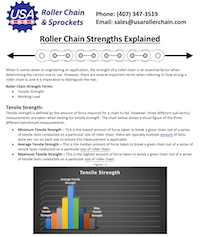Strongest Roller Chain and Roller Chain Capacity Guide

We often get asked, what is the strongest roller chain? So, we decided to create this section listing the strongest roller chains in the world! We offer the broadest selection of roller chains on the planet at USA Roller Chain, ranging from ANSI to Metric sizes, and from each size, we selected the absolute strongest chain option on the market to display below, along with a comprehensive guide to explain roller chain capacity and what their values mean.
Strongest ANSI Roller Chains
Strongest Metric Roller Chains
Understanding Roller Chain Capacity: A Comprehensive Guide

Roller chains are vital components in many mechanical systems, providing efficient power transmission and motion control. Understanding a roller chain's capacity is crucial to ensuring that it can handle the demands of your application without failure. The guide below will explain the key factors that determine roller chain capacity and how to choose the right chain for your needs.
What is Roller Chain Capacity?
Roller chain capacity refers to the maximum load (tensile strength) and stress (working load) a chain can handle during operation. This includes both the tensile strength and the chain's fatigue resistance/ working load. Properly assessing the capacity ensures the chain performs reliably and safely under the expected operating conditions.
Key Factors Affecting Roller Chain Capacity
- Tensile Strength: The maximum amount of tension a chain can withstand before breaking. Ensures the chain can handle the peak loads encountered during operation.
- Working Load: The ability of the chain to withstand repeated loading and unloading cycles without failure. Critical for applications with frequent starts, stops, or variable loads.
- Pitch: The distance between the centers of two consecutive pins. It affects the chain's ability and overall strength to engage with sprockets.
- Roller Diameter and Width: The size of the rollers and the width between inner plates. Influences the chain's engagement with sprockets and load distribution.
- Material and Construction: Includes factors like heat treatment and surface finishing. Choose materials and construction techniques that match the environmental conditions and load requirements. Common options/ materials include stainless steel, carbon steel, nickel-plated, and coated steel.
- Lubrication and Maintenance: Reduces friction and wear, extending chain life and maintaining capacity.
Steps to Determine Roller Chain Capacity
- Identify Load Requirements: Calculate the maximum and average loads the chain will encounter. Consider both static and dynamic loads.
- Assess Operational Environment: Evaluate factors like temperature, humidity, and exposure to chemicals. Select materials and lubrication that can withstand these conditions.
- Consult Manufacturer Specifications: Review manufacturer catalogs for tensile strength and working load ratings. Compare these ratings with your application requirements.
- Consider Safety Margins: Select a chain with a capacity that exceeds the expected loads by a safe margin. This accounts for unexpected conditions and ensures reliability.
- Regular Maintenance: Implement a maintenance schedule to inspect and lubricate the chain. Address wear and potential issues promptly to maintain capacity. Please refer to our roller chain maintenance selection for more details.
Conclusion
Understanding roller chain capacity is essential for selecting the proper chain for your application. Considering factors like tensile strength, working load, and material selection, you can ensure that your roller chain will perform reliably under the expected conditions. Regular maintenance and consultation with manufacturers can further enhance chain performance and longevity.
PDF Download - 
|



